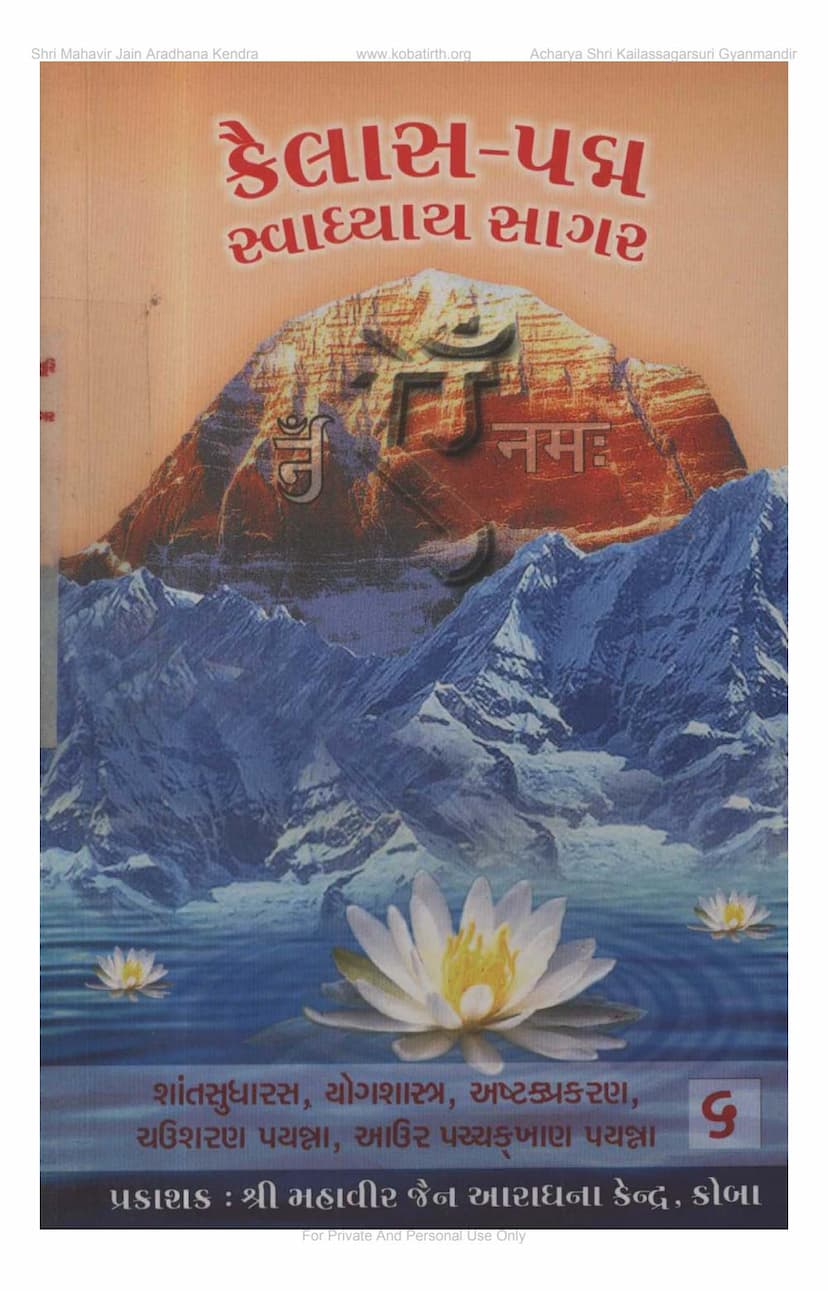Kailaspadma Swadhyayasagara Part 6
Added to library: September 2, 2025

Summary
This document is a collection of Jain texts, compiled as "Kailaspadma Swadhyayasagara Part 6" by Acharya Shri Padmaratnasagar, and published by Shri Mahavir Jain Aradhana Kendra Koba. The book is intended for private and personal use only.
The content is presented in Gujarati and Sanskrit, featuring devotional and philosophical verses, hymns, and treatises. It is organized into various sections, each dedicated to a specific text or theme.
Key Texts and Themes Identified:
- Shrimad Shant Sudharas (based on Upadhyaya Vinayvijayji): This section seems to focus on the essence of peace and spiritual nectar, likely exploring principles of equanimity and inner calm through verse. Pages 12-23 contain verses from this work.
- Yogashastra (by Acharya Hemchandrasuri): This is a significant portion of the book, detailing the principles and practices of Yoga within the Jain tradition. It covers topics like the nature of Yoga, its benefits, the importance of the Three Jewels (Samyak Darshan, Samyak Gyan, Samyak Charitra), the five vows (Mahavratas), and various ethical and disciplinary guidelines for ascetics and householders. Pages 46-118 are dedicated to this text.
- Ashtak Prakaran (by Acharya Haribhadrasuri): This section comprises various "Ashtakas," which are collections of eight verses dedicated to specific deities or themes. The identified Ashtakas include:
- Mahadev Ashtakam: Verses dedicated to a supreme being, likely Mahadev as understood in a Jain context. (Pages 93-94)
- Nananashtakam: Likely deals with different types of purification or cleansing. (Page 94)
- Pujashtakam: Verses related to worship, possibly detailing the significance of offerings. (Page 94)
- Agnikadikastakam: Discusses rituals involving fire or offerings. (Page 95)
- Bhiksha Ashtakam: Explores the principles and types of alms-seeking for ascetics. (Pages 96-97)
- Prachchhannabhojan Ashtakam: Discusses the concept of concealed or discreet eating. (Page 98)
- Pratyakhyanashtakam: Relates to renunciation or vows. (Page 98)
- Jnan Ashtakam: Focuses on knowledge and its acquisition. (Page 99)
- Vairagya Ashtakam: Deals with detachment and renunciation. (Page 100)
- Tapo Ashtakam: Explores the significance and practice of austerities. (Page 101)
- Vada Ashtakam: Discusses different types of discourse or debate. (Page 102)
- Dharmavada Ashtakam: Focuses on the nature of righteous discourse. (Page 103)
- Ekanityanitya Pakshakhandan Ashtakam: Likely argues against specific philosophical viewpoints concerning the soul's nature. (Pages 103-104)
- Mansabhakshan Dushana Ashtakam (Two Parts): Discusses the flaws and prohibitions associated with eating meat. (Pages 105-107)
- Madyapan Dushana Ashtakam: Addresses the issues related to alcohol consumption. (Page 107)
- Maithun Dushana Ashtakam: Discusses the limitations and prohibitions regarding sexual misconduct. (Page 108)
- Sukshmabuddhi Ashravana Ashtakam: Relates to understanding subtle principles. (Page 109)
- Bhavavishuddhi Vichara Ashtakam: Explores the purification of one's inner state. (Page 110)
- Shasan Malindanishadha Ashtakam: Discusses avoiding practices that tarnish the Jain tradition. (Page 111)
- Papanubandhipurvada Vivarana Ashtakam: Likely details the consequences of past actions. (Page 111)
- Punyanubandhipunya Phalashthakam: Focuses on the results of virtuous deeds. (Page 112)
- Tirthkṛtanamahattvasishya Ashtakam: Discusses the significance of Tirthankaras and their disciples. (Page 113)
- Tirthkṛdanamahattvasishya Ashtakam (Second Part): Continues the discussion on Tirthankaras and their teachings. (Page 114)
- Rajyabhidanepatihṛtudoshabhavaprati pada Ashtakam: Discusses the lack of fault in certain acts performed by Tirthankaras for the welfare of the world. (Page 115)
- Samayika Roop Nirupana Ashtakam: Defines the nature of Samayika (equanimity or daily meditation). (Page 116)
- Keval Jñana Ashtakam: Focuses on omniscience. (Page 117)
- Moksha Ashtakam: Discusses the concept of liberation or Moksha. (Page 118)
- Chausaran Payanna: This section likely contains verses or principles related to the Fourfold Refuge (Arhat, Siddha, Sadhu, Dharma). Pages 119-132 contain these verses.
- Aatur Pachchhakhan Patha: This section appears to be related to fasting or vows taken during times of illness or distress. Pages 125-131 contain these verses.
Overall Purpose and Tone:
The book serves as a spiritual guide and repository of Jain knowledge, emphasizing ethical conduct, detachment, self-discipline, and the pursuit of liberation. The verses are often didactic, aiming to educate and inspire the reader towards spiritual growth and the observance of Jain principles. The compilation likely aims to make these important texts accessible to the Jain community for personal study and contemplation.
The presence of revered Acharyas and Gurus associated with the publication highlights its authoritative and devotional nature. The mention of "Kailas-Padma Swadhyaya Sagar" as being dedicated to Acharya Shri Padmasagarsuri reinforces its connection to the lineage and teachings of prominent Jain monks.